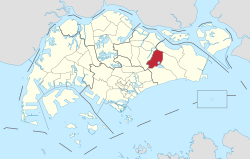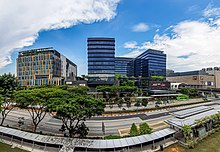Paya Lebar
Paya Lebar | |
|---|---|
| Other transcription(s) | |
| • Malay | Paya Lebar (Rumi) ڤايا ليبر (Jawi) |
| • Chinese | 巴耶利峇 Bāyē Lìbā (Pinyin) Pa-iâ Lī-bā (Hokkien POJ) |
| • Tamil | பாய லேபார் Pāya lēpar (Transliteration) |
 Location of Paya Lebar in Singapore | |
| Coordinates: 1°21′12″N 103°53′37″E / 1.3533°N 103.8937°E | |
| Country | |
| Region | East
|
| Government | |
| • Mayors | ---- |
| Area | |
| • Total | 11.69 km2 (4.51 sq mi) |
| Population (2022) | |
| • Total | 30 |
| • Density | 2.6/km2 (6.6/sq mi) |
| Ethnic groups | |
Paya Lebar (/ˈpɑːjɑː ˌleɪbɑː/ PAH-ya LAY-bar) is a planning area located in the East Region of Singapore, bordered by Hougang to the west, Sengkang to the northwest, Tampines to the east, Bedok to the south and Pasir Ris to the north.
As part of the Singapore Urban Redevelopment Authority's (URA) Master Plan 2014,[1] Paya Lebar Central[2] was identified as one of the five growth areas. It was since earmarked as an up-and-coming commercial hub, in line with the wider decentralisation strategy to ensure the city's sustainable growth. Paya Lebar participates in the pilot Business Improvement District (BID) programme.
Although they have similar names, Paya Lebar Central, Paya Lebar MRT Station and Paya Lebar Road are not part of Paya Lebar Planning Area, instead are part of Geylang East planning subzone, part of Geylang.

Etymology and history
[edit]Paya Lebar was formerly a swamp close to Kallang River. In Malay, Paya means "swamp" and lebar means "wide".[3]
Due to the swamp, the area mainly consisted of squatters who reared pig and poultry and also grew market produce.[3]
In 1865, Richard Owen Norris bought part of the area and lived there with his family.[3]
Paya Lebar Air Base
[edit]The Singapore International Airport was built in Paya Lebar from 1952 to 1955, and opened on 20 August that year by the Secretary of State for the Colonies, Alan Lennox-Boyd.[4] Singapore International Airport began to be gradually converted into a military air-force base from late 1967 onwards. It became a complete military airbase in 1981 when Singapore Changi Airport was opened and was subsequently renamed as Paya Lebar Air Base (PLAB) in the same year.
Politics
[edit]Paya Lebar covers Aljunied GRC and Tampines GRC which were warded by the Workers' Party and the People's Action Party, respectively. One notable Member of Parliament for the ward was the former Secretary-General of the Workers' Party, Low Thia Khiang, where his ward covers a majority of Paya Lebar, including the Paya Lebar Air Base. Following his retirement, it was taken over by Gerald Giam.
See also
[edit]References
[edit]- ^ "Master Plan 2014". www.ura.gov.sg.
- ^ "Paya Lebar Central". www.ura.gov.sg. Archived from the original on 13 February 2019.
- ^ a b c Savage, Victor R. (2013). Singapore street names : a study of toponymics. Brenda S. A. Yeoh. Singapore. p. 57. ISBN 978-981-4484-74-9. OCLC 868957283.
{{cite book}}: CS1 maint: location missing publisher (link) - ^ "The Door to Singapore". The Straits Times. 21 August 1955. Retrieved 21 March 2014.

